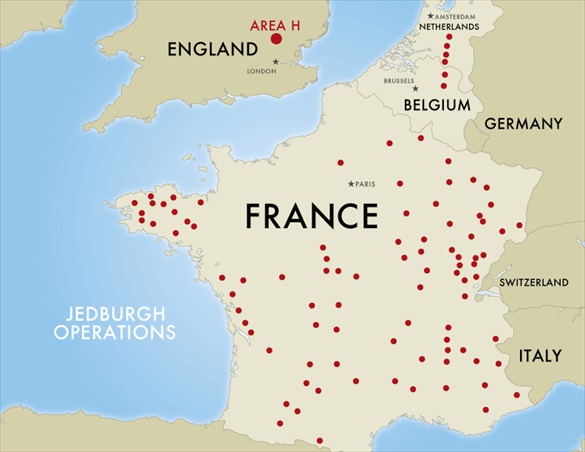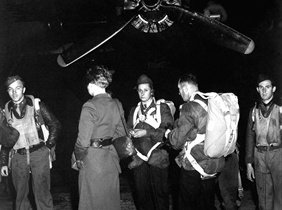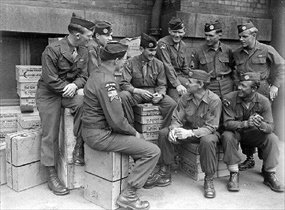JEDBURGHS, FRENCH RESISTANCE TEST NAZI HOLD ON FRANCE
RAF Fairford, England and Blida near Algiers, Algeria • June 9/10, 1944
In planning the successful June 6, 1944, sea- and airborne invasion of German-occupied Normandy, France, Supreme Allied Commander of the Allied Expeditionary Force, Gen. Dwight D. Eisenhower, fully appreciated the necessity of coordinating French Resistance actions with the Allies’ strategic and tactical plans before, during, and after launching Operation Overlord. SHAEF staff perceived multiple roles for the disparate French resistance networks, cells, partisan supporters, and Allied sympathizers. They included promoting open resistance on as wide a scale as possible, delaying or preventing enemy counterattacks after the D‑Day landings, interfering with enemy railroad and highway movements and enemy telecommunications, destroying fuel and ammunition dumps, and limiting the potential for Germans on the run to destroy key French infrastructure.
The Allies restricted the number of organizations that could liaise with the French underground to 3: the American Office of Strategic Services (OSS), the British Special Operations Executive (SOE), and the Free French Central Bureau of Intelligence and Action (Bureau Central de Renseignements et d’Action, BCRA). Jointly they created volunteer liaison teams known as Jedburghs named after a celebrated group of 12th-century Scottish guerrillas. The Jedburgh command took up residence at Special Forces Headquarters (SFHQ) in Baker Street, London. Jedburgh candidates trained at various locations in Scotland and England.
The typical 3‑member Jedburgh team consisted of an American, British, or Canadian officer, a French officer (as native speaker), and a radio operator of either nationality. Parachuting behind enemy lines, Jedburgh commandos sought out local resistance networks to inform them of upcoming Allied actions and solicit their assistance. In the process they provided radio communications between SFHQ headquarters and rural resistance fighters (résistants) known by their moniker maquisards after the sparsely populated regions, forests, or mountains where they hid out (maquis). The Jedburghs arranged for clandestine airdrops of needed supplies and, as necessary, provided weapons and explosives training, sometimes even leading résistants in sabotage, ambush, and guerrilla operations. Readied for deployment by late April 1944, SHAEF waited until the night of June 5/6 to deploy the first Jedburgh team, codenamed “Hugh,” to Central France (Center-Val de Loire) near Châteauroux.
On this night, D+4, June 9/10, 1944, 3 Jedburgh teams (Frederick, George, and Gilbert) took off from England and 1 (Ammonia) from Algeria for Brittany (home to 20,000 partisans) and Southwest France, respectively. The Jedburghs and résistants fought the enemy far in front of Allied invasion forces as the latter painfully slogged their way across France. In some instances, Jedburghs and résistants took and held key infrastructure like bridges the Allied forces wouldn’t reach for weeks. Most often, however, the Jedburghs lived up to their motto: “Surprise, kill, and vanish.”
The last Jedburgh team to be deployed in France in June (Hamish) left on D+7 (June 12/13) for Central France. In July, August, and September Jedburgh insertions into France kicked into high gear and also included drops in the Netherlands. In all 93 Jedburgh teams were deployed on French soil and 8 on Dutch (see map below for locations). By partnering with resistance fighters in German-occupied Europe, the Jedburghs forced the enemy to divert significant military assets away from major confrontations with Allied armies. By tying up so many German units, much key infrastructure survived the Wehrmacht’s destructive efforts. When Jedburgh areas of operations were eventually liberated by Allied forces, Jedburgh missions terminated.
Operation Jedburgh, 1944: Guerrilla Warfare Behind Enemy Lines
 |
Above: Map showing the insertion sites of Jedburgh commandos behind German lines in France and the Netherlands. There were no Jedburgh insertions into neighboring Belgium. Ninety-three Jedburgh teams were deployed on French soil during the Battle of Normandy and operations to clear the Germans from France (June to December 1944). Eight teams were deployed to the Netherlands, three-quarters of them around the time of the failed Market Garden operation (September 17–25, 1944). A postwar tally put the total number of Jedburgh commandos at 276, of which 83 were Americans, 90 were British or Canadian, and 103 were French. American casualties were tiny: 6 killed, 7 wounded, and 2 survived capture. After seeing action in Northwestern Europe, some Jedburgh commandos carried out similar missions in Norway, Italy, Burma, Malaysia, Borneo, Indonesia, China, and French Indochina (today Vietnam, Cambodia, and Laos). Forty former French Jedburgh volunteers left Europe to fight the Japanese in French Indochina in 1944–1945.
 |  |
Left: Aircrew, woman officer, and Jedburgh commandos fitted with parachutes, life vests, and other gear prepare to embark on a mission from Harrington Airfield in England on the Consolidated B‑24 Liberator in the background. The aircraft, stripped of most armament, unneeded radio gear, its underside painted black to avoid detection by enemy searchlights, was modified with “Joe holes” through which the commandos jumped. The jumps would have been completed before daybreak. In June and July 1944 the U.S. Army Air Forces’ 801 Bombardment Group (Provisional), nicknamed “Carpetbaggers,” flew 1,300 Jedburgh sorties to France, the majority originating from RAF Harrington in Northamptonshire in Central England (labeled “Area H” on the above map). On September 16, 1944, the 801 Group ceased Carpetbagger missions.
![]()
Right: Several nationalities can be seen in this photo of Jedburghs taking a break. In addition to the all-important task of supplying arms and other items to resistance fighters and preparing landing and dropping fields, Jedburgh commandos provided weapons and explosive training, acted as translators and interpreters assisting in surrender arrangements with the enemy, helped erect roadblocks and lead sabotage and ambush operations, provided tactical intelligence on resistance and enemy strength and other information to their London headquarters, and worked to coordinate disparate, often competing resistance forces under the SHAEF-sanctioned, unified command of the FFI, Forces françaises de l’Intérieur, after February 1944. On June 9, 1944, Eisenhower turned over command of the Jedburgh teams to the French.
Resisting Hitler: The French Resistance, 1940–1944
![]()

 History buffs, there is good news! The Daily Chronicles of World War II is now available as an ebook for $4.99 on Amazon.com. Containing a year’s worth of dated entries from this website, the ebook brings the story of this tumultuous era to life in a compelling, authoritative, and succinct manner. Featuring inventive navigation aids, the ebook enables readers to instantly move forward or backward by month and date to different dated entries. Simple and elegant! Click
History buffs, there is good news! The Daily Chronicles of World War II is now available as an ebook for $4.99 on Amazon.com. Containing a year’s worth of dated entries from this website, the ebook brings the story of this tumultuous era to life in a compelling, authoritative, and succinct manner. Featuring inventive navigation aids, the ebook enables readers to instantly move forward or backward by month and date to different dated entries. Simple and elegant! Click 











